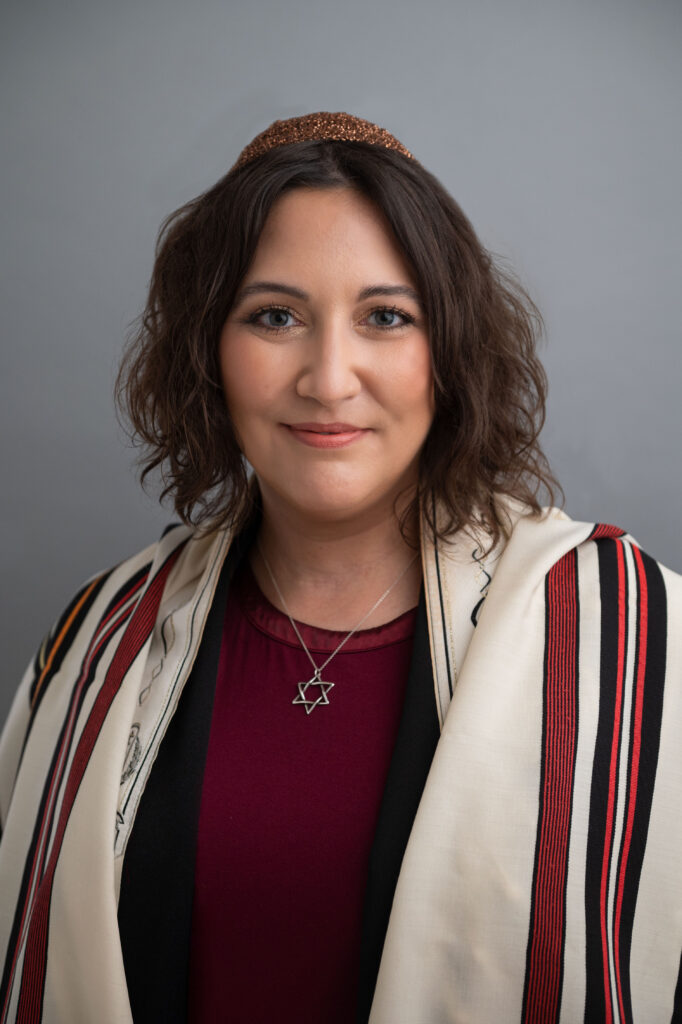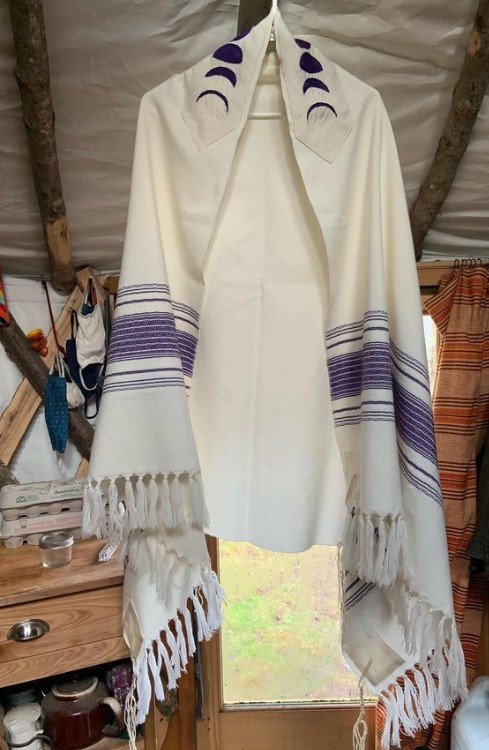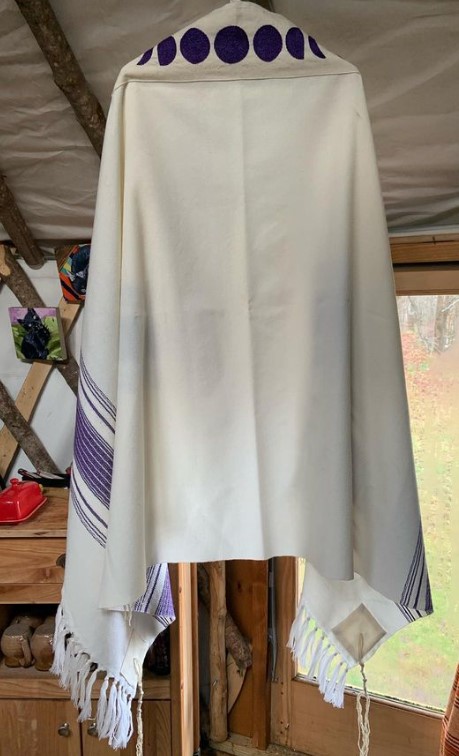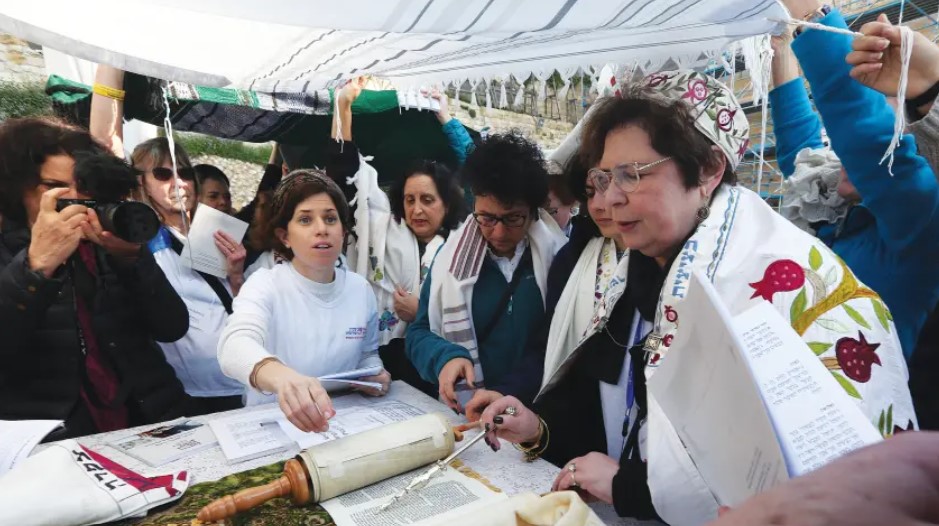My conversation with Rabbi Minster centered on how Judaism can fit into an individual’s life. We talked about the importance of the personal interpretation of ancient rituals and beliefs, and the ways that these rituals can live on in the modern day. It was important for me to have this conversation with her; I had been struggling with this idea of an ancient ritual and tradition that could connect me to “my people,” when in fact women had been excluded from this ritual until only a few decades ago, and Orthodox Jewish women still do not wear a tallit.
Women were granted the right to wear a tallit and pray out loud at the Western Wall in Jersalem in 2014. In 2016, women were granted the right to read the Torah and hold service at the Wall, an agreement that was repealed in 2017. Women still face harassments, assault, and arrests for wearing a tallit to this day.
Women make space for themselves at the Western Wall, using and wearing tallitot
On tallit, place making, and sense making

Sam: Would you mind just starting there, with your connection, whatever that means for you, with a tallit?
Rabbi Minster: “I grew up in a conservative community and it was normal for girls to wear a kippah and a tallit at their Bat Mitzvah and beyond. It was presented to me that if you’re going to take the obligations of becoming a Bat Mitzvah, that includes wearing a head covering and a tallit. I’ve never questioned whether or not to wear a tallit. I wear one during morning services because I am a Jew older than 13.
It has taken on a different meaning now that I am regularly a shaliach tzibbur, a prayer leader (literally those words mean “messenger of the community” — by leading the prayers, a shaliach tzibbur is a voice for members of the community who do not know how to say the prayers themselves.) As the Temple Israel shaliach tzibbur, I am often the only person wearing a tallit because our regularly scheduled services are at night, when people don’t traditionally wear tallits. So it has become a symbol of my communal leadership.
Plus, there was a whole thing around getting pictures in a tallit taken for my ordination. And now that photograph follows me every week, as it was placed in the Temple Israel weekly e-newsletter.”
Sam: You mentioned there were moments of precarity for women in your congregation. Maybe not in wearing a tallit, but were there any other actions performed as a form of physical assertion of one’s place in the community?
Rabbi Minster: “My mom has never worn a tallit. What she did was start attending the weekday minyan at a Conservative synagogue to say the Mourner’s Kaddish for her mother when she passed. The men in charge of that minyan did not want to count her for a minyan (which would mean that the service would not include the Mourner’s Kaddish). She took a political stand demanding that the daily minyan conform to the egalitarian perspective of the larger synagogue– since women counted for minyan on Shabbat, they should also count on weekdays. It had nothing to do with ritual garments. Just who counts as a Jew for a minyan.
Post-interview notes from Rabbi Minster
I realized driving to the synagogue today why I had to tell you the story about my mom. It’s part of the larger thread that my mom, though not particularly educated Jewishly, was the driving force behind ensuring that her daughters got equal access to Judaism as her son. My dad grew up Orthodox and had never heard of it, but followed my mom’s lead. And the example of her forcing the weekday minyan to count women is proof that at the time (in the 1980s) this was still a political minefield in progressive Conservative Judaism.
“My larger act, my ritual, symbolism choice is actually in wearing a kippah everyday. I would pray three times a day and I realized it was ridiculous to take it on and off. If I always have it on, there’s no “off,” I don’t have to feel like I’m transitioning into something when I start to pray, and in wearing it, I can always feel that I am always surrounded by the divine.
But it’s also helped me from being in my head so much. Using these objects, you know I also have stones and jewelry… and using these objects are helpful for visualizing whatever’s going on in your head, and hopefully helps reconnect you with what’s important to you.”
Sam: How how many tallitot do you have now?
Rabbi Minster: “I have four. The one I got for my bat mitzvah, the bigger one the tallit gadol, the one I have for High Holy days, and the one I got for my ordination.
The first tallit gadol I wore was my grandfather’s. He gave it to me at the same time he gave me his Chai necklace. I was really proud to wear it. I wore it for a couple of years and then he asked for it back because he decided he wanted to be buried in it. I was hurt by the decision because I really felt connected to him wearing his tallit. This may have contributed to my delight in wearing jewelry owned by him.
In my 30s, when I returned to Judaism, I bought the tallit gadol version of my Bat Mitzvah tallit. I didn’t realize it at the time, but it is a design created by Rabbi Zalman Schachter-Shalomi, the founder of Jewish Renewal. I attended the Davvenen Leadership Training Institute (a two year retreat program organized by Jewish Renewal) and appreciate the way that strand of Judaism opened up Hasidic teachings to progressive Jews.
I definitely looked out of place at my rabbinic student internship wearing such a big tallit. I also didn’t really understand how to use clips to keep it in place. So, when I found a smaller white tallit on sale in the synagogue gift shop, I bought it both to conform to expectations and to have a white tallit for the High Holy Days. Ironically, I misplaced it in my move up to the Bay Area and didn’t wear it last High Holy Days and don’t really plan on wearing it that much in the future.
I found Black Cat Judaica on Instagram and fell in love with the weaver and the idea of owning a tallit where I knew who had weaved the wool and designed the tallit. Plus, the creator is female, which is relatively difficult to find for Jewish ritual objects. I love it so much because the stripes are purple and the atarah phases of the moon are also purple. It’s a deeply spiritual color and I feel wrapped in my authentic self wearing it.”


Sam: So I’ve really been struggling with this idea of…. Choice versus the covenant. How do you connect then, to a ritual that wasn’t always for you?
Rabbi Minster: “I have trouble with that. Like I said, it’s a man’s religion. But even growing up, in my congregation there was always that disconnect: we were talking about commandments that no one is doing.
I’ve always thought of it as: what are the rituals and practices that tie you spiritually to Judaism? That’s what Reform Judaism teaches: you learn the Torah, you learn about the commandments, and then you choose what you can add to your life, and what will add to your life. I think about, what are the rituals that are meaningful to me? Ritual helps ground you, and helps you take time for yourself and for your soul.
I also don’t mean to disparage the idea of commandments or Judaism generally. Just that I recognize those words aren’t as forceful or compelling to many progressive Jews as they once were.”
Sam: So what do you say when people come to you, and they have this textual knowledge about Jewish rules and rituals, how do you offer that guidance, if it stands against the Torah?
Rabbi Minster: Well, I’m a Reform rabbi. No one comes to me looking for rules. My job is to create a space that is open and welcoming. My job is to create a safe space for people to practice the rituals that are meaningful to them.
Prayer has always been a center, a grounding place. It’s like I’m reaching towards God, and wanting to hold a space for my soul and the souls around me. I’ve always seen the soul as embodied life, and spiritual life. I don’t like it when people think… when they say tikkun olam, and they think it means repairing the world, like the whole world. It actually means, repairing the world within yourself. Some people need that spiritual grounding.”
Rabbi Minster: “As a rabbi, I should be requiring everyone to wear a kippah when they enter the sanctuary. I should be requiring people to wear a tallit when the Torah is being read. We’re not like Christians you know, who take off their hat when they enter the prayer space– we put one on. We put on more clothing to pray, we put on the tallit. We have some available on the rack in the back of the sanctuary, so anyone can take one and put it on, even if they don’t have their own or didn’t bring it.
And I do feel… there is guilt in that. I feel guilty.
Wearing objects is an embodied connection with prayers. I used to bind myself with the tefillin, and that’s a physical binding to the tradition, that’s very powerful to me. And the prayers you say during that are actually the same prayers you would say on your wedding day, as a part of your vows.
Sam: What’s the prayer?
Rabbi Minster: “The prayer for wrapping tefillin around your fingers begins, “I will betroth you to me forever.” It’s a great meditation on what it means to be aligned with HaShem and with another person. I used to say that everyday and I was like, I can’t wait to say that when I’m married.”
Sam: You said there’s guilt. Why do you feel guilty?
Rabbi Minster: “Because I don’t say it anymore! I can’t pray in the mornings, I don’t have time. I have kids who need to be woken up and fed and bathed and put together, there’s just no time.”
Sam: Life gets in the way.
Rabbi Minster: “Yes, life gets in the way. But, you have to find the space for yourself and for Judaism in your life. I put makeup on in the mornings; that’s become my little ritual in a way. It’s a moment of space and peace and reflection.”
Post-interview notes from Rabbi Minster
I figured out why I stopped praying every day. My prayer practice was an embodied practice as much because of how I prayed as for the ritual articles that I added to my body. When I was a child, I mocked my dad for shuckling while he prayed. When I started to do it, I realized that it helped with my concentration and that it allowed my whole body to participate in prayer. I shuckled forward and backward. And then, I developed arthritis in my lower back during the pandemic. I actually had never connected these two things until you asked this question that has been circling my brain for several years. The reality is that I can’t shuckle back and forth anymore. One service, I shuckled side to side and a congregant thought I was drunk. So I’m still finding my prayer posture and I also need to relearn the art of sitting and praying. That’s something else I don’t have the ability to do when I’m shaliach tzibbur.
